 |
Nursery Workshop |
| Home Recommend This Site To A Friend |
|
SRGC Nursery Workshop 1 29 JANUARY 2004 26th January, frost has not given all day and the weathermen tell us blizzards are heading our way, an ideal time to sow seed! Many seeds benefit from vernalisation i/e a good frosting, this breaks down the protective cover which some seeds have,( seeds sown naturally in the wild are open to all the elements.) Sources of good seed:- Scottish Rock Garden Club, srgc.org.uk Alpine Garden Society, ags.org.uk The Meconopsis Group, meconopsis.org (meconopsis only) 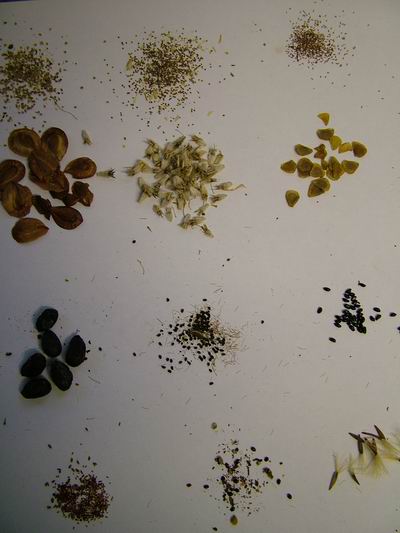
Seeds on card Seeds are fascinating every plant has it's own unique seed and I show here a few variations. Compost mixes for you to try:- MIX NO 1 A peat free compost for seed sowing, potting etc. 1 part John Innes sterilised soil ( I use no 3 but any will do) 1 part sharp grit or chippings 1 part composted bark Cambark fine or Melcourt bark (B and Q also sell small bales Composted bark.) MIX NO 2 Use 50% of No. 1 compost 50 % grit Use this as a layer for sowing the seed on and as a top dressing. METHOD:- Fill a pot or tray three quarters full with No.1 compost, Take mix No.2 and fill pot to within 5cm top of the pot or tray Sprinkle seeds on this layer. Use horticultural grit or mix No.2 to cover seeds lightly. If you prefer, Vermiculite or Perlite can be added instead of grit to mixes, it is very important to follow manufacturers instructions and water this before use as dust from both is harmful. Seed should germinate in the top gritty layer then as seedlings grow and roots extend downwards seedlings will receive extra nourishment from lower layer. If you prefer to delay potting until the following year give weak solutions of liquid feed during the growing season and provide cover for the young plants over the worst of the winter months. Seed container:- Choose suitable size of pot for the amount of seed you wish to sow be it a seed tray, small or large pot. 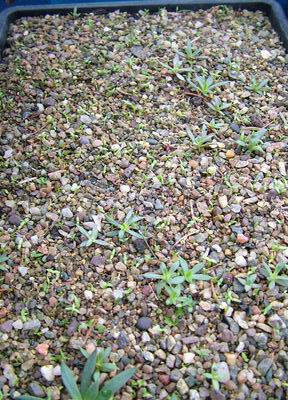
Lewisia's in tray Seed sowing methods:- Fine seed: eg. Meconopsis, Primulas and Gentians. 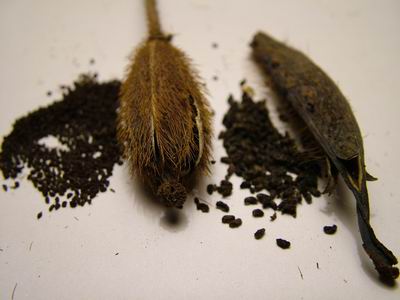
Meconopsis seed pods Place seed in a strawberry punnet or empty margarine tub, using protective gloves very carefully add a little fungicide powder and mix together thus coating the seed with the white powder, you can then see how much seed is sown on surface of compost plus fungicide may help to stop damping off once germination occurs, cover seed lightly with sharp grit and place all outside. 
9cm seed pots grit Juicy seed: eg. Hellebores, Erythroniums, Paeonia, Trillium and Daphne. Fill a pot three quarters full with Mix No.1 add a thin layer of 50% grit 50% compost mixed, sow seed and cover with a good layer of grit or chippings (2or 3 mm). Next take a piece of fleece the white see through kind, cut a square big enough to overlap the top of the pot, tie fleece with string under the pot rim like a Christmas pudding this prevents field voles and mice from eating your seed during the winter and also has the added advantage of keeping out slugs and snails once seed germinates, pull fleece up slightly to give seedlings space as they grow. 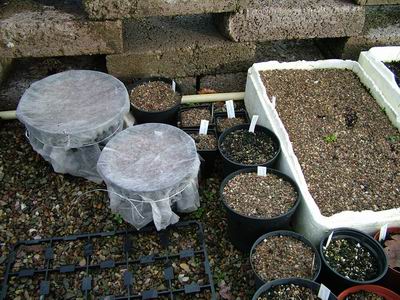
seed pots with fleece In the first year of germination we do not prick out seedlings of any of the above mentioned genera but liquid feed during season to promote healthy growth. During winter we place seedlings under cover until growth restarts in the Spring they are then potted up with little disturbance into a bigger pot or planted in a clear spot in the garden or nursery bed to grow on for a year or two. By year three seedlings should be big enough for potting or can be lined out in garden/nursery area. Trillium seedlings are left in the garden without disturbance until we feel they are large enough to be planted individually or in groups in the garden. Hellebores are potted up into deep pots and are liquid fed regularly to promote flowering. As you can see from this picture I have covered seed 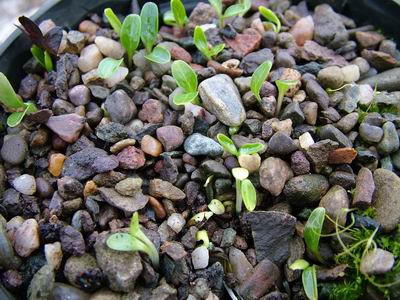
Helleborus hybridus seedlings with fairly large pea gravel, I find some large seed on germination push up all the soil as they are so strong, the big gravel prevents this and seedlings are not hindered by this but please experiment yourselves. 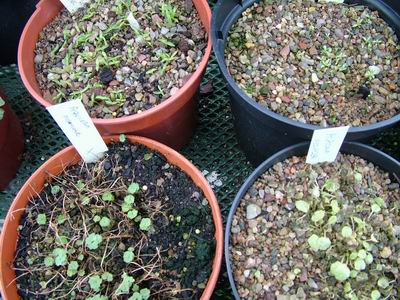
seed germinated Fresh seed: Hellebore, Hepatica, Trillium, Pulsatilla, Celmisia, Erythronium and Daphne. I have found that seed from the above mentioned plants are best sown fresh from the pod or alternatively if you prefer, sow half your seed immediately and keep the rest in the fridge until winter thus giving you two bites of the cherry. Most fresh seed will germinate within 2 to 3 weeks during the growing season this can create a problem in that the small seedlings are still quite tender as the cooler weather approaches for this reason I leave them in their seed pot and find a space under cover for the winter. All our seed pots are placed out side in a frame where we have the ability if necessary to provide basic cover if the winter proves severe or excessive rainfall occurs. 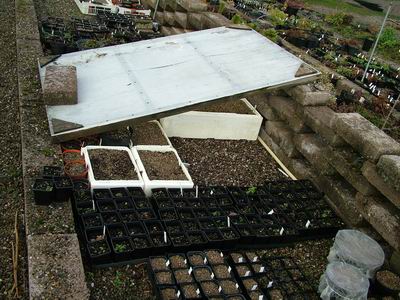
Seed sown 2 You will also notice the added mousetrap which we put under a basket or black crate during daytime to keep out the cat or small birds this is checked every morning, we then await the emergence of our seeds. 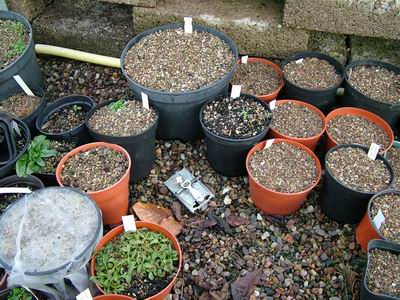
seed with trap If you live in a frost free area seeds can be stored inside a polythene bag along with some grit or slightly damp perlite, tie or seal bag then place in the deep freeze for a week or so, (I emphasise your bag of seed should have a very clear label or someone may use them as a top dressing for their lunch). Sow seeds in the usual manner. We generally check seed pots at regular intervals especially when it is very wet a cover can be put over some pots for a short time and if some seeds have started to germinate we may take these in to cold glasshouse etc. Pricking out seedlings: 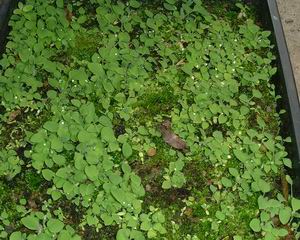
Meconopsis seedlings 1 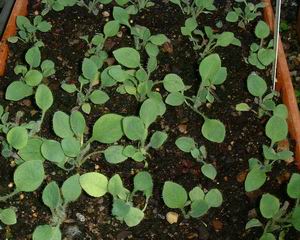
Meconopsis seedlings 2 Once big enough prick out seedlings into cell packs and water. Protect from direct sunlight to avoid scorching, I often use wooden lids and cover them with green netting. Water with care I have killed a lot more seedlings by over watering than the lack of it. Finally success comes to those who wait, yes we are ready to pot up or plant out. Winter chores I check evergreen plants in the greenhouse at this time because Aphids, Greenfly and other nasties do not necessarily stop because it is winter, plants with dormant flower buds can be decimated in a short time. I also keep an eye on the growing bulbous plants for any signs of damage by mice and voles another good reason for keeping a cat, they are not always bad! Last years leaves from our hellebores are removed to reveal the buds and forthcoming flowers. 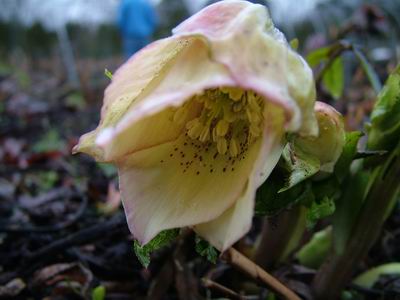
hellebore flwrs 1 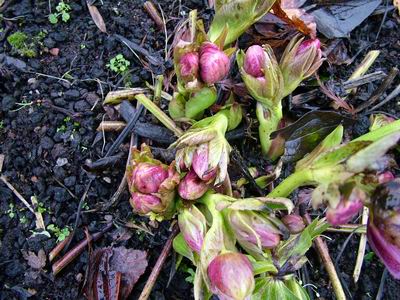
Hellebore plant I am watching Blue tits inspecting our nest box from the window as I type this so spring must be around the corner, good luck with your seed sowing etc and watch out for next workshop. ^ back to the top ^ |